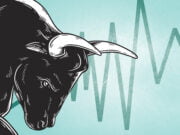When the Venetian merchant Marco Polo got to China, in the latter part of the thirteenth century, he saw many wonders—gunpowder and coal and eyeglasses and porcelain. One of the things that astonished him most, however, was a new invention, implemented by Kublai Khan, a grandson of the great conqueror Genghis. It was paper money, introduced by Kublai in 1260. Polo could hardly believe his eyes when he saw what the Khan was doing:
He makes his money after this fashion. He makes them take of the bark of a certain tree, in fact of the mulberry tree, the leaves of which are the food of the silkworms, these trees being so numerous that whole districts are full of them. What they take is a certain fine white bast or skin which lies between the wood of the tree and the thick outer bark, and this they make into something resembling sheets of paper, but black. When these sheets have been prepared they are cut up into pieces of different sizes. All these pieces of paper are issued with as much solemnity and authority as if they were of pure gold or silver; and on every piece a variety of officials, whose duty it is, have to write their names, and to put their seals. And when all is prepared duly, the chief officer deputed by the Khan smears the seal entrusted to him with vermilion, and impresses it on the paper, so that the form of the seal remains imprinted upon it in red; the money is then authentic. Anyone forging it would be punished with death.
That last point was deeply relevant. The problem with many new forms of money is that people are reluctant to adopt them. Genghis Khan’s grandson didn’t have that difficulty. He took measures to insure the authenticity of his currency, and if you didn’t use it—if you wouldn’t accept it in payment, or preferred to use gold or silver or copper or iron bars or pearls or salt or coins or any of the older forms of payment prevalent in China—he would have you killed. This solved the question of uptake.
Marco Polo was right to be amazed. The instruments of trade and finance are inventions, in the same way that creations of art and discoveries of science are inventions—products of the human imagination. Paper money, backed by the authority of the state, was an astonishing innovation, one that reshaped the world. That’s hard to remember: we grow used to the ways we pay our bills and are paid for our work, to the dance of numbers in our bank balances and credit-card statements. It’s only at moments when the system buckles that we start to wonder why these things are worth what they seem to be worth. The credit crunch in 2008 triggered a panic when people throughout the financial system wondered whether the numbers on balance sheets meant what they were supposed to mean. As a direct response to the crisis, in October, 2008, Satoshi Nakamoto, whoever he or she or they might be, published the white paper that outlined the idea of Bitcoin, a new form of money based on nothing but the power of cryptography.
The quest for new forms of money hasn’t gone away. In June of this year, Facebook unveiled Libra, global currency that draws on the architecture of Bitcoin. The idea is that the value of the new money is derived not from the imprimatur of any state but from a combination of mathematics, global connectedness, and the trust that resides in the world’s biggest social network. That’s the plan, anyway. How safe is it? How do we know what libras or bitcoins are worth, or whether they’re worth anything? Satoshi Nakamoto’s acolytes would immediately turn those questions around and ask, How do you know what the cash in your pocket is worth?
The present moment in financial invention therefore has some similarities with the period when money in the form we currently understand it—a paper currency backed by state guarantees—was first created. The hero of that origin story is the nation-state. In all good stories, the hero wants something but faces an obstacle. In the case of the nation-state, what it wants to do is wage war, and the obstacle it faces is how to pay for it.
The modern system for dealing with this problem arose in England during the reign of King William, the Protestant Dutch royal who had been imported to the throne of England in 1689, to replace the unacceptably Catholic King James II. William was a competent ruler, but he had serious baggage—a long-running dispute with King Louis XIV of France. Before long, England and France were involved in a new phase of this dispute, which now seems part of a centuries-long conflict between the two countries, but at the time was variously called the Nine-Years’ War or King William’s War. This war presented the usual problem: how could the nations afford it?
King William’s administration came up with a novel answer: borrow a huge sum of money, and use taxes to pay back the interest over time. In 1694, the English government borrowed 1.2 million pounds at a rate of eight per cent, paid for by taxes on ships’ cargoes, beer, and spirits. In return, the lenders were allowed to incorporate themselves as a new company, the Bank of England. The bank had the right to take in deposits of gold from the public and—a second big innovation—to print “Bank notes” as receipts for the deposits. These new deposits were then lent to the King. The banknotes, being guaranteed by the deposits, were as good as gold money, and rapidly became a generally accepted new currency.
This system is still with us, and not just in England. The more general adoption of the scheme, however, was not a story of uninterrupted success. Some of the difficulties are recounted in James Buchan’s fascinating “John Law: A Scottish Adventurer of the Eighteenth Century.” Law was the Edinburgh-born son of a goldsmith turned banker. He moved to London in 1692, where he observed the wondrous new scheme of government paid for by long-term debt and paper money. One of the most significant effects of the paper money was the way it stimulated borrowing and lending—and trading. Law had an instinctive understanding of finance and a love of risk, and it is tempting to wonder what would have happened if he had lent his services to the English government. Instead, on April 9, 1694, a different fate was set in motion. He killed a man in a duel, or brawl—the distinction, as Buchan explains, was not all that clear. “Duels then were not the tournaments of the Middle Ages or the affairs of honour of later years, governed by written codes of conduct and discharged at dawn with pistols in some snowy forest clearing,” he writes. They might be conducted “with rapiers or short swords in hot or barely cooling blood, sometimes with seconds drawn and fighting, and shading away into assassination and armed robbery.” Law was sent to prison to await a murder trial. He used his connections to get out, as prisoners of means did, and fled abroad as an outlaw.
Law spent the next few years knocking around Europe, learning about gambling and finance, and writing a short book, “Money and Trade Considered,” which in many respects foreshadows modern theories about money. He became rich; like Littlefinger in “Game of Thrones,” Law seems to have been one of those men who had the knack of “rubbing two golden dragons together and breeding a third.” He bought a fancy house in The Hague and made a close study of the many Dutch innovations in finance, such as options trading and short selling. In 1713, he arrived in France, which was beset by a problem he was well suited to tackle.
The King of France, Louis XIV, was the preëminent monarch in Europe, but his government was crippled by debt. The usual costs of warfare were added to a huge bill for annuities—lifelong interest payments made in settlement of old loans. By 1715, the King had a hundred and sixty-five million livres in revenue from taxes and customs. Buchan does the math: “Spending on the army, the palaces and court and the public administration left just 48 million livres to meet interest payments on the debts accumulated by the illustrious kings who had gone before.” Unfortunately, the annual bill for annuities and wages of lifetime offices came to ninety million livres. There were also outstanding promissory notes, amounting to nine hundred million livres, left over from various wars; the King wouldn’t be able to borrow any more money unless he paid interest on those notes, and that would cost an additional fifty million livres a year. The government of France was broke.
In September of 1715, Louis XIV died, and his nephew the Duke of Orleans was left in charge of the country, as regent to the child king Louis XV. The Duke was quite something. “He was born bored,” the great diarist Saint-Simon, a friend of the Duke’s since childhood, observed. “He could not live except in a sort of torrent of business, at the head of an army, or in managing its supply, or in the blare and sparkle of a debauch.” Facing the financial crisis of the French state, the Duke started listening to the ideas of John Law. Those ideas—more or less orthodox policy today—were wildly original by the standards of the eighteenth century.
Law thought that the important thing about money wasn’t its inherent value; he didn’t believe it had any. “Money is not the value for which goods are exchanged, but the value by which they are exchanged,” he wrote. That is, money is the means by which you swap one set of stuff for another set of stuff. The crucial thing, Law thought, was to get money moving around the economy and to use it to stimulate trade and business. As Buchan writes, “Money must be turned to the service of trade, and lie at the discretion of the prince or parliament to vary according to the needs of trade. Such an idea, orthodox and even tedious for the past fifty years, was thought in the seventeenth century to be diabolical.”
This idea of Law’s led him to the idea of a new national French bank that took in gold and silver from the public and lent it back out in the form of paper money. The bank also took deposits in the form of government debt, cleverly allowing people to claim the full value of debts that were trading at heavy discounts: if you had a piece of paper saying the king owed you a thousand livres, you could get only, say, four hundred livres in the open market for it, but Law’s bank would credit you with the full thousand livres in paper money. This meant that the bank’s paper assets far outstripped the actual gold it had in store, making it a precursor of the “fractional-reserve banking” that’s normal today. Law’s bank had, by one estimate, about four times as much paper money in circulation as its gold and silver reserves. That is conservative by modern banking standards. A U.S. bank with assets under a hundred and twenty-four million dollars is obliged to keep a cash reserve of only three per cent.
The new paper money had an attractive feature: it was guaranteed to trade for a specific weight of silver, and, unlike coins, could not be melted down or devalued. Before long, the banknotes were trading at more than their value in silver, and Law was made Controller General of Finances, in charge of the entire French economy. He also persuaded the government to grant him a monopoly of trade with the French settlements in North America, in the form of the Mississippi Company. He funded the company the same way he had funded the bank, with deposits from the public swapped for shares. He then used the value of those shares, which rocketed from five hundred livres to ten thousand livres, to buy up the debts of the French King. The French economy, based on all those rents and annuities and wages, was swept away and replaced by what Law called his “new System of Finance.” The use of gold and silver was banned. Paper money was now “fiat” currency, underpinned by the authority of the bank and nothing else. At its peak, the company was priced at twice the entire productive capacity of France. As Buchan points out, that is the highest valuation any company has ever achieved anywhere in the world.
It ended in disaster. People started to wonder whether these suddenly lucrative investments were worth what they were supposed to be worth; then they started to worry, then to panic, then to demand their money back, then to riot when they couldn’t get it. Gold and silver were reinstated as money, the company was dissolved, and Law was fired, after a hundred and forty-five days in office. In 1720, he fled the country, ruined. He moved from Brussels to Copenhagen to Venice to London and back to Venice, where he died, broke, in 1729.
The great irony of Law’s life is that his ideas were, from the modern perspective, largely correct. The ships that went abroad on behalf of his great company began to turn a profit. The auditor who went through the company’s books concluded that it was entirely solvent—which isn’t surprising, when you consider that the lands it owned in America now produce trillions of dollars in economic value.
Today, we live in a version of John Law’s system. Every state in the developed world has a central bank that issues paper money, manipulates the supply of credit in the interest of commerce, uses fractional-reserve banking, and features joint-stock companies that pay dividends. All of these were brought to France, pretty much simultaneously, by John Law. His great and probably unavoidable mistake was to underestimate the volatility that his inventions introduced, especially the risks created by runaway credit. His period of brilliant success in France left only two monuments. One was created by the Duke of Bourbon, who cashed out his shares in the company and used the windfall to build the Great Stables at Chantilly. “John Law had dreamed of a well-nourished working population and magazines of home and foreign goods,” Buchan notes. “His monument is a cathedral to the horse.” His other legacy is the word “millionaire,” first coined in Paris to describe the early beneficiaries of Law’s dazzling scheme.
How did these once wild ideas become part of the very fabric of modern finance and government? Trial and error. It was not the case that smart people figured everything out at once and implemented it simultaneously, as Law tried to do. The modern economic system evolved, and evolution involves innovations, repetitions, failures, and dead ends. In finance, it involves busts and panics and crashes, because, as James Grant says in his lively new biography of the Victorian banker-journalist Walter Bagehot, “in finance and economics, we keep stepping on the same rakes.”
Bagehot (pronounced “badge-it”) knew all about those rakes. He grew up in the West of England in a family with strong links to a well-run local bank, Stuckey’s. After going to university and trying his hand at being a lawyer, he turned to journalism and to banking, the latter career paying for the former. He married the daughter of James Wilson, who had founded The Economist, in 1843—Bagehot became its third editor—and lived a life that was, from the outside, fairly uneventful. The interest in Bagehot comes from his dazzling, witty, paradox-loving writing, and in particular from his two key works, “The English Constitution” (1867), which sums up the unwritten order of Great Britain’s political institutions, and “Lombard Street” (1873), which explains how banking works. These books are still readable today, but they were of interest mainly to wonks until Ben Bernanke name-checked Bagehot as a crucial influence on the thinking behind the 2008 bank bailouts. That caused a revived interest, which led to the writing of Grant’s “Walter Bagehot: The Life and Times of the Greatest Victorian.”
“Greatest” is a loaded word, especially since Grant—who is, among other things, the founder of Grant’s Interest Rate Observer—makes it clear that Bagehot was an unashamed misogynist and racist (“There are breeds in the animal man just as in the animal dog”) and an accomplished hypocrite. The last quality was useful from the journalistic point of view; Bagehot was brilliant at swapping sides without ever admitting that he had changed his mind. A Confederate victory in the Civil War, for instance, was “a certain fact,” and President Lincoln was “dishonest and foolish,” a settled view that didn’t preclude Bagehot from declaring, once the Union had prevailed, that “panic did not for a moment unnerve the iron courage of the American democracy.” His subsequent elegy for Lincoln is a genuinely lovely piece of writing: “Difficulties, instead of irritating him as they do most men, only increased his reliance on patience; opposition, instead of ulcerating, only made him more tolerant and determined.”
In a sense, this highfalutin hypocrisy and lack of principle is the point of Bagehot. His work on the English constitution focussed on a paradox: the pomp and circumstance of monarchy had an important function, he argued, precisely because the monarch had no real power. Bagehot’s work on banking similarly focussed on the difference between appearances and realities, specifically the gap between the air of solidity and respectability cultivated by Victorian banks and the evident fact that they kept collapsing and going broke. There were huge bank crises in 1797, in 1825, in 1847, and in 1857, all of them caused by the oldest and simplest reason of bankruptcy in finance: lending money to people who can’t pay it back.
In theory, all the money in circulation during the era of Victorian banking was backed up by deposits in gold. One pound in paper money was backed by 123.25 grains of actual gold. In practice, that wasn’t true. There were multiple occasions—usually linked to the cost of that old classic, war with France—when the government suspended the convertibility of paper money to gold. In addition, banks could print their own money. They often didn’t have enough gold to sustain the value of their notes, in the event of customers coming to the bank and demanding conversion. That phenomenon, the dreaded “bank run,” was a direct outcome of the fractional-reserve banking prefigured by John Law. A system in which banks don’t hold cash reserves equivalent to their outstanding loans works fine, unless enough people turn up at the bank and simultaneously want their paper money turned into its metal equivalent. Unfortunately, that kept happening, and banks kept going broke. The issues at stake were the same as those that had shaped the career of John Law, and which are on people’s minds again today: What is money? Where does it derive its value? Who finally guarantees the value of debts and credits?
Bagehot had answers to all those questions. He thought that money, real money, was gold, and gold alone. All the other forms of currency in the system were merely different kinds of credit. Credit was indispensable to a functioning economy, and helped make everybody rich, but in the final analysis only gold was legal tender, according to the strict definition of the term—money that cannot be refused in settlement of a debt. (U.S. currency makes sure you know it is legal tender: it says so right there on the front.) Bagehot loved a paradox, and this was one: all the credit in the system was essential to the economy, but it wasn’t really money, because it wasn’t gold, which underpinned the value of everything else.
So where was all the gold? In the Bank of England. The role of that once private company had evolved. Bagehot thought it was the Bank of England’s job to hold the gold, so that all the smaller banks didn’t have to. Instead, the smaller banks took deposits, made loans, and issued paper money. If they got into trouble—which they tended to do—the big bank would bail them out. Why shouldn’t all the other banks hold their own gold, and take care of their own solvency? Bagehot the banker-writer was completely frank about the reason. “The main source of the profitableness of established banking is the smallness of the requisite capital,” he wrote. The modern way of putting this would be to talk about the bank’s return on equity. The less equity the bank needed to keep as a margin of safety, the more money it could lend, and, therefore, the more profit it could make. Gold was essential in order to guarantee the currency, but the bankers didn’t want it taking up valuable space on their balance sheets. Better to let the government do that, in the form of the Bank of England.
We still have a version of this system, in which government guarantees underpin the profitability of banks. The central bank’s crucial role is to lend money freely at a time of crisis—to be what is called “the lender of last resort.” Grant, who admits to “a libertarian’s biases,” sees this doctrine as the seed of “deposit insurance, the too-big-to-fail doctrine, and the rest of the modern machinery of socialized financial risk.”
Like John Law and Walter Bagehot, I’m the child of a man who worked in a bank, and, as such, I had a banker’s-son question running through my mind as I read Grant’s entertaining book: what happened to Bagehot’s bank? The answer is that Stuckey’s was taken over by another bank, Parr’s, in 1909. Parr’s was part of the larger National Westminster Bank, which was taken over by the Royal Bank of Scotland, in 2000. R.B.S., as it is unaffectionately known in the U.K., grew through takeovers to become, in the early years of this century, the biggest company in the world, as measured by the size of its balance sheet. Then came the credit crunch, and the moment—the latest version of the old familiar one—when things turned out not to be worth what they were supposed to be worth. The biggest bank in the world came, according to its chairman, to within “a couple of hours” of complete collapse. The outcome was a huge bailout, and the nationalization of R.B.S., with costs to the British taxpayer of forty-five billion pounds. Not much about that story would have surprised John Law or Walter Bagehot. Maybe, though, both men—the man who almost bankrupted a country and the supreme advocate of bankers’ bailouts—would be amused to see just how little we have learned. As for the question of what to do about the bankers responsible for the crash, Kublai Khan would probably have had some ideas. ♦
Click here to see the full story








